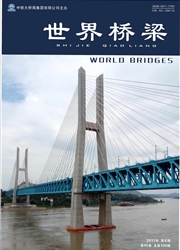

 中文摘要:
中文摘要:
为探索极限荷载作用下,冲击系数计算值与规范规定值的关系,为实际工程中桥梁冲击系数计算提供参考,参照《89桥规》选择车辆,采用二轴、三轴和五轴车辆的半车模型,依据桥梁检测规范中荷载效应的概念,将车辆荷载与规范的极限荷载标准值进行对应,按照车桥耦合振动分析方法进行冲击系数研究。通过计算某30m跨径简支T梁桥在各级汽车荷载作用下的挠度,得到冲击系数,并将结果与《89桥规》、《04桥规》取值进行比较,分析结果表明:当荷载较小时,计算的冲击系数相对于规范值偏大,当荷载效应接近于1时,即车辆荷载在桥梁结构响应的意义上与规范极限荷载接近时,计算所得冲击系数满足《04桥规》中关于冲击系数的规定,说明《04桥规》中关于冲击系数的规定是合理的。
 英文摘要:
英文摘要:
In order to identify the relationship between the calculated value of impact coefficient and the value suggested in the code in the context of ultimate load and to provide references for impact coefficient calculation of real bridge projects, the vehicles used for the tests were chosen by consulting the code (1989), adopting the models of half of the vehicles with two axles, three axles and five axles respectively. Following the concept of load effect designated in the bridge in- spection code, the vehicle loads were paired with the standard values of ultimate load in the code, and then, the analytical method of vehicle-bridge coupling vibration was used to carry out impact coefficient study. The deflection of a simply-supported T beam bridge spanning 30 m under the ve- hicle loads of different grades was calculated to gain the impact coefficient, and the results were compared with the values suggested in the code (1989) and the code (2004). The results of the a- nalysis demonstrates that when the load is small, the calculated impact coefficient is greater than the suggested value, but when the load effect approaches 1, that is, when the vehicle load is in the proximity to the ultimate load in the code in terms of the bridge structural response, the impact coefficient gained from the calculation meets the requirements of impact coefficient in the code ('2004), which indicates that the suggestion for impact coefficient in the code (2004) is rational.
 同期刊论文项目
同期刊论文项目
 同项目期刊论文
同项目期刊论文
 期刊信息
期刊信息
